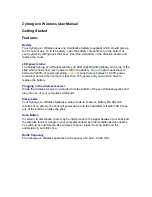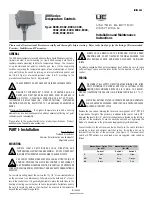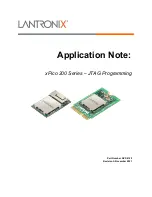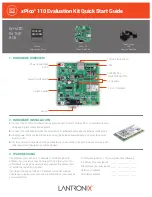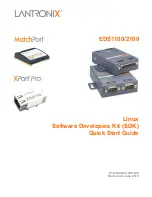
CHAPTER 5: SETTINGS
GROUPED ELEMENTS
L30 LINE CURRENT DIFFERENTIAL SYSTEM – INSTRUCTION MANUAL
5-213
5
5.7.3.2 Stub bus
SETTINGS
GROUPED ELEMENTS
SETTING GROUP 1(6)
LINE DIFFERENTIAL ELEMENT
STUB BUS
The stub bus element protects for faults between two breakers in a breaker-and-a-half or ring bus configuration when the
line disconnect switch is open. At the same time, if the line is still energized through the remote terminal(s), differential
protection is still required (the line can still need to be energized because there is a tapped load on a two-terminal line or
because the line is a three-terminal line with two of the terminals still connected). Correct operation for this condition is
achieved by the local relay sending zero current values to the remote end(s) so that a local bus fault does not result in
tripping the line. At the local end, the differential element is disabled and stub bus protection is provided by a user-selected
overcurrent element. If there is a line fault, the remote end(s) trips on differential but local differential function and the DTT
signal (if enabled) to the local end are blocked by the stub bus logic, allowing the local breakers to remain closed.
STUB BUS FUNCTION
— There are three requirements for stub bus operation: the element must be enabled, an indication
that the line disconnect is open, and the
STUB BUS TRIGGER
setting is set. There are two methods to set the stub bus trigger
and thus setting up stub bus operation, as follows:
1.
If
STUB BUS TRIGGER
is “On,” the
STUB BUS OPERATE
operand picks up as soon as the disconnect switch opens, causing
zero currents to be transmitted to remote end(s) and DTT receipt from remote end(s) to be permanently blocked. An
overcurrent element, blocked by disconnect switch closed, provides protection for the local bus.
2.
An alternate method is to set
STUB BUS TRIGGER
to be the pickup of an assigned instantaneous overcurrent element.
The instantaneous overcurrent element must operate quickly enough to pick up the
STUB BUS OPERATE
operand,
disable the local differential, and send zero currents to the other terminal(s). If the bus minimum fault current is above
five times the instantaneous overcurrent pickup, tests have confirmed that the
STUB BUS OPERATE
operand always
picks up correctly for a stub bus fault and prevents tripping of the remote terminal. If minimum stub bus fault current
is below this value, then use method 1. Note also that correct testing of stub bus operation, when this method is used,
requires sudden injection of a fault currents above five times instantaneous overcurrent pickup. The assigned current
element needs to be mapped to the appropriate output contact(s) to trip the stub bus breakers. It should be blocked
unless disconnect is open. To prevent 87L tripping from remote L30 relays still protecting the line, assign the auxiliary
contact of line disconnect switch (logic “1” when line switch is open) to block the local 87L function by using the
CURRENT DIFF BLOCK
setting.
STUB BUS DISCONNECT
— Selects a FlexLogic operand to represent the open state of auxiliary contact of line disconnect
switch (logic “1” when line disconnect switch is open). If necessary, simple logic representing not only the line disconnect
switch but also the closed state of the breakers can be created with FlexLogic and assigned to this setting.
STUB BUS TRIGGER
— Selects a FlexLogic operand that causes the
STUB BUS OPERATE
operand to pick up if the line disconnect
is open. It can be set either to “On” or to an instantaneous overcurrent element (as outlined). If the instantaneous
overcurrent used for the stub bus protection is set with a time delay, then
STUB BUS TRIGGER
should use the associated
instantaneous overcurrent pickup operand. The source assigned for the current of this element must cover the stub
between CTs of the associated breakers and disconnect switch.
STUB BUS
STUB BUS FUNCTION:
Disabled
Range: Disabled, Enabled
STUB BUS DISCONNECT:
Off
Range: FlexLogic operand
STUB BUS TRIGGER:
Off
Range: FlexLogic operand
STUB BUS TARGET:
Self-reset
Range: Self-reset, Latched, Disabled
STUB BUS EVENTS:
Disabled
Range: Disabled, Enabled
Содержание L30
Страница 10: ...x L30 LINE CURRENT DIFFERENTIAL SYSTEM INSTRUCTION MANUAL TABLE OF CONTENTS ...
Страница 14: ...1 4 L30 LINE CURRENT DIFFERENTIAL SYSTEM INSTRUCTION MANUAL FOR FURTHER ASSISTANCE CHAPTER 1 INTRODUCTION 1 ...
Страница 126: ...3 68 L30 LINE CURRENT DIFFERENTIAL SYSTEM INSTRUCTION MANUAL CONNECT TO D400 GATEWAY CHAPTER 3 INSTALLATION 3 ...
Страница 214: ...4 88 L30 LINE CURRENT DIFFERENTIAL SYSTEM INSTRUCTION MANUAL FLEXLOGIC DESIGN USING ENGINEER CHAPTER 4 INTERFACES 4 ...
Страница 582: ...7 16 L30 LINE CURRENT DIFFERENTIAL SYSTEM INSTRUCTION MANUAL TARGETS MENU CHAPTER 7 COMMANDS AND TARGETS 7 ...
Страница 598: ...9 6 L30 LINE CURRENT DIFFERENTIAL SYSTEM INSTRUCTION MANUAL TESTING CHAPTER 9 COMMISSIONING 9 ...
Страница 622: ...10 24 L30 LINE CURRENT DIFFERENTIAL SYSTEM INSTRUCTION MANUAL FAULT LOCATOR CHAPTER 10 THEORY OF OPERATION 10 ...
Страница 670: ...A 18 L30 LINE CURRENT DIFFERENTIAL SYSTEM INSTRUCTION MANUAL FLEXANALOG ITEMS APPENDIX A FLEXANALOG OPERANDS A ...
Страница 678: ...C 6 L30 LINE CURRENT DIFFERENTIAL SYSTEM INSTRUCTION MANUAL COMMAND LINE INTERFACE APPENDIX C COMMAND LINE INTERFACE C ...
Страница 682: ...D 4 L30 LINE CURRENT DIFFERENTIAL SYSTEM INSTRUCTION MANUAL REVISION HISTORY APPENDIX D MISCELLANEOUS D ...
Страница 686: ...iv L30 LINE CURRENT DIFFERENTIAL SYSTEM INSTRUCTION MANUAL ABBREVIATIONS ...

































